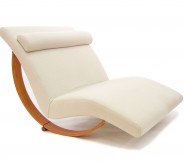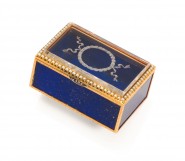Lot #22 - Howard Arkley
-
Auction House:Deutscher and Hackett
-
Sale Name:Important Fine Art Auction
-
Sale Date:28 Nov 2012 ~ 7pm
-
Lot #:22
-
Lot Description:Howard Arkley
1951 – 1999
Spray Veneer (Vernice A Spruzzo), 1994
synthetic polymer paint on canvas
203.0 x 153.0 cm
signed, dated, titled verso: Howard Arkley / Spray Veneer / 1994 / ... -
Provenance:Tolarno Galleries, Melbourne; Collection of Allan Powell, Melbourne, acquired from the above in 1994
-
Exhibited:Howard Arkley, Tolarno Galleries, Melbourne, November 1994, cat. 4; Howard Arkley: The Home Show, Australian Pavilion, 48th Venice Biennale of Art, Venice, Italy, 13 June – 7 November 1999 (lent by Mr Allan Powell, Melbourne); The Home Show, Ian Potter Gallery, Melbourne, 2000 (lent by Mr Allan Powell, Melbourne); Howard Arkley: The Retrospective, National Gallery of Victoria, Melbourne, 17 November 2006 – 25 February 2007; Art Gallery of New South Wales, Sydney, 10 March – 6 May 2007; Queens
-
References:Crawford, A., and Edgar, R., Spray: The Work of Howard Arkley, Craftsman House, Sydney, 1997, pp. 125, 135 (illus.); Morrell, T., Howard Arkley: The Home Show, Australia Council for the Arts, Sydney, 1999, p. 19 (illus.); Szeemann, H., and Liveriero Lavelli, C. (eds), La Biennale Di Venezia: 48a Espozione Internazionale d’arte, Marsilio, Venice, 1999, p. 7 (illus.); Gregory, J., Carnival in Suburbia, the Art of Howard Arkley, Cambridge University Press, 2007, pp. 118–119 (illus.); Arkley Wor
-
Notes:If ever a painting was the essence of Howard Arkley’s exploration of suburban kitsch, it would be quite rightfully his masterpiece Spray Veneer of 1994. The title alone, which was lyrically called Vernice a Spruzzo when exhibited at the 48th Venice Biennale in 1999, is laden with multiple meanings and takes us directly to the very heart of his obsession – the facadism and ‘ticky tacky’ of the middle class conformist housing project when it collides with an individual’s need for self expression. Not only does Arkley capture the inherent tension in this moment, he celebrates it without judgement and free of any hint of sanctimony. His lurid, carnival palette and fantasy motifs applied with the spray gun mirror the very artifice of veneer itself, which as we know was a favourite architectural device of the 1940s and 50s employed to cover over the mundane banality of the base layer and suggest a finesse and solidity which was not real. Veneer also allowed for ‘variations’, such as mock stone and brick work, timber cladding and stucco surfaces, all designed to proffer a sense of individuality to the new homebuilder. By their very nature, these veneers only created the illusion of individuality and ultimately they became a symbol of a flimsy suburban conformism as immortalised in the Malvina Reynolds’ classic of 1963 sung by Peter Seeger, Little Boxes: Little boxes on the hillside, Little boxes made of ticky-tacky, Little boxes, little boxes, Little boxes, all the same. There’s a green one and a pink one And a blue one and a yellow one And they’re all made out of ticky-tacky And they all look just the same.1 The greatness of Arkley’s work, especially a monumental example such as Spray Veneer, resides not just in his message or narrative about suburbia but also with his chosen medium of the air gun. His use of spray is the knockout punch in the paradigm. Spray paint is the veneer of the art world replete with all of its connotations of custom painting and commercial sign writing and which has now been so cleverly adapted to represent the avant-garde, non-conformism, vandalism and street art. There is a type of ‘tackiness’ or mass culture element to its characteristic. The spray gun conjures up a lavish repertoire of stock images, customised and exaggerated for each customer. It alludes to fanciful panel van illustrations of sunsets and bikini clad women, devils and fire balls to cast the illusion that a car is so much more than an engine and duco. Spray paint functions just like veneer in the housing estate. Not only did Arkley capitalise on its look as a medium, it also allowed him to use a palet te so outlandish, saturated and psychedelic that his visions were automatically charged. As Timothy Morrell observes, ‘Howard Arkley’s paintings turn the Australian dream into an hallucination.’2 Of almost equal consideration is the scale of the works and what that signifies. Spray Veneer comes from a series of works, which had its genesis in a Tolarno Galleries show in 1988, ‘Recent Paintings: Houses and Homes’ followed by ‘Blue Chip Instant Decorator: A Room’ in collaboration with Juan Davila in 1991. The project emerged fully formed in ‘The Pointillist Suburb Series’ again at Tolarno Galleries in 1994, where Spray Veneer was acquired by its present owner. The works in this group of house and home paintings are largely of a uniform size (203.0 x 153.0cm) and appear to replicate the scale and dimension of the typical real estate sales board erected outside properties to spruik a home’s infinite, transformative qualities to prospective home owners. In these advertisements, there is a sense of gilding the lily and enhancing a home’s features, a sense of scaling up a property to lure in the market. Arkley’s neon palette and juxtaposed colours and mixed up patterns takes this trait and amplifies it beyond recognition taking the ordinary and everyday and transforming it into the fantastical and theatrical. When Spray Veneer was selected to be exhibited at the 48th Venice Biennale in 1999 it was one of a group of panels painted between 1994 and 1999, all of which were mostly of a uniform size and scale, including the 17 panelled work Fabricated Rooms, 1997–99, Light and Bright, 1994, Mosaic Entrance, 1994, Indoors – Outdoors, 1994, Housemorphics, 1996 (Wesfarmers Collection of Australian Art, Perth), Floriated Residence, 1994, Actual Fractural, 1994 and Theatrical Facade, 1996 (Parliament House Art Collection, Canberra). The effect of these ‘house’ panels when exhibited at Venice was explosive. The entire Biennale precinct situated in the giardini appears like a great theatre set, the ultimate cultural ‘home show’ of all nations. The Philip Cox designed Australian Pavilion itself is the very model of the modern Australian house and to exhibit such an overblown narrative on Australian domestic life in such a context intensified the underlying concept and lent a great sense of theatrical irony to the entire Ark
-
Estimate:A$250,000 - 300,000
-
Realised Price:
-
Category:Art
This Sale has been held and this item is no longer available. Details are provided for information purposes only.










